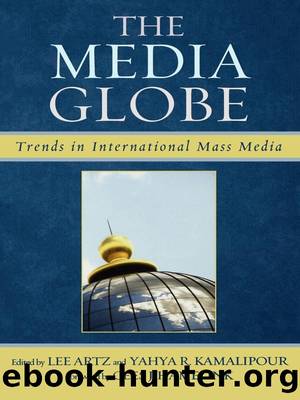The Media Globe by Unknown

Author:Unknown
Language: eng
Format: epub
ISBN: 9781461644781
Publisher: Rowman & Littlefield Publishers
Published: 2013-07-11T00:00:00+00:00
FROM REGIONALIZATION TO NICHE MARKETS
As we previously mentioned, the regionalization of Arab media was both a result of and a contributing factor to a convergence of technological and policy trends. Technologically, the advent of NILESAT created competition with ARABSAT, providing additional space for satellite transmission and reducing costs for broadcasters throughout the Middle Eastern and North African regions that fall under the footprint of both satellites. Beyond these technological advancements, policy developments were crucial in promoting and facilitating regionalization. First, most Arab governments relaxed policies initially designed to ban or control the spread of satellite dishes, and even where repressive official policies are maintained, laws are rarely enforced. Second, countries like the United Arab Emirates, Egypt, and Jordan established âfree-media zonesâ with tax incentives and liberal labor regulations that enabled the pooling of resources and consolidation of talent. The Dubai Media City, the indisputable leader in this regard, now hosts dozens of regional and global corporate giants in broadcasting, information technology, advertising, and publishing. In addition, there are âunofficial free-media zonesâ in countries such as Lebanon and to a lesser extent Morocco, where educational, cultural, and business traditions promote media production.
The new satellite channels attempted at first to replace terrestrial channels with a mix of news and entertainment. The pioneer in this âgeneral formatâ category was the aforementioned Middle East Broadcasting Center (MBC), which was in short time followed by others such as the Lebanese Broadcasting Corporationâs satellite channel, the Lebanon-based Future Television, and to a lesser extent the Egyptian Dream TV. With news, each presented its ownersâ distinct political viewpoint, which differentiated these channelsâ newscasts from the âcourt newsâ style of official government television channels, whose newscasts lingered on the political and social activities of the countriesâ leaders. The new channels occasionally featured political dissidents, who broached sensitive topics that were never discussed on official television, thus raising the ceiling for political speech in the Arab region. At the same time, these same channels presented a new style of entertainment programs, characterized by high production values, a level of sensuality, and narrative dynamism that is more akin to the U.S. commercial network style than to the television productions of the developing world and even Europe.
Initially successful, these general mixed-format channels soon faced fierce competition from satellite pay-services. Pay-television entities such as Arab Radio and Television (ART), Orbit, and Showtime were interested in cultivating a niche audience willing to pay a subscription fee. It was just a matter of time before the market for generalist channels became saturated and new free-to-air broadcasters would have to move to a niche market strategy with audience segmentation. These developments made channels like MBC unsustainable and compelled them to reexamine their strategies at a time when niche strategy was becoming an increasingly viable option. Industry developments pushing for specialization and audience segmentation included the availability of unprecedented satellite space offered with financial incentives to broadcasters, the presence of production centers and free-media zones with proliferating production abilities, and the influence of the advertising industry,
Download
This site does not store any files on its server. We only index and link to content provided by other sites. Please contact the content providers to delete copyright contents if any and email us, we'll remove relevant links or contents immediately.
Asking the Right Questions: A Guide to Critical Thinking by M. Neil Browne & Stuart M. Keeley(5576)
Autoboyography by Christina Lauren(5155)
Eat That Frog! by Brian Tracy(4381)
Dialogue by Robert McKee(4272)
Sticky Fingers by Joe Hagan(4060)
Journeys Out of the Body by Robert Monroe(3539)
Annapurna by Maurice Herzog(3398)
Full Circle by Michael Palin(3350)
Schaum's Quick Guide to Writing Great Short Stories by Margaret Lucke(3280)
Elements of Style 2017 by Richard De A'Morelli(3280)
The Art of Dramatic Writing: Its Basis in the Creative Interpretation of Human Motives by Egri Lajos(2945)
Why I Write by George Orwell(2851)
The Diviners by Libba Bray(2841)
In Patagonia by Bruce Chatwin(2830)
The Mental Game of Writing: How to Overcome Obstacles, Stay Creative and Productive, and Free Your Mind for Success by James Scott Bell(2819)
The Fight by Norman Mailer(2801)
Atlas Obscura by Joshua Foer(2759)
Venice by Jan Morris(2496)
The Elements of Style by William Strunk and E. B. White(2416)
